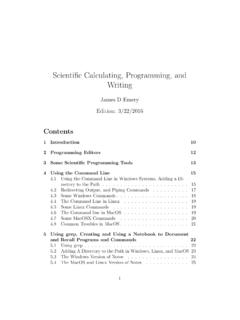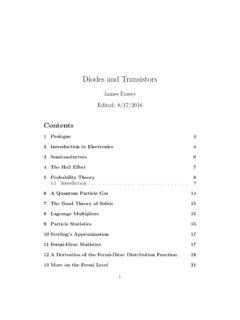Transcription of Cherenkov Radiation - Stem2
1 Cherenkov RadiationJames Emery5/17/2009 Contents1 Introduction12 WaveMotion23 The Phase and Group Velocity of Waves34 Shock Waves45 The Theory and Spectrum of Cherenkov Radiation46 Nuclear Reactors67 CosmicRays68 Cherenkov Particle Detectors79 Bibliography and References71 IntroductionThe Russian physicists Cherenkov , Frank, and Tamm, received the 1964 Nobel prize in physics for their work on Cherenkov example of a wave is the periodic sin function, as a function of time,sin( t).A traveling wave is a function of both space and time, for examplesin(kx t),or (x, t)=aexp(i(kx t)).Because every periodic function may be expanded in a Fourier series, we mayconsider only the trigonometric functions of the form (x, t)=aexp(i(kx t)).
2 Herekis the wave number and is the angular frequency. The wave lengthis the period of the function with respect to time. For a fixed timet,thewave length is the spacial distance between corresponding phase points,that is phase points where (x+ , t0)= (,t0)So that, for example,cos(k(x+ ) t0)=cos(kx t0)ork(x+ ) t0 (kx t0)=2 ork =2 .So =2 the time between corresponding phase points whenxis held fixed. So in a manner similar to the wavelength calculation, we findthe period to beT=2 .2 The frequency is the reciprocal of the periodf= phase velocity is the speed that a point on the traveling wave moves one wavelength in periodT. Thus the so called phase velocity,being the velocity of a point at a givin phase in the cycle, isv= T=2 /k2 / = k= The Phase and Group Velocity of WavesThe concept of group velocity was first treated by Lord Rayleigh.
3 Accordingto a reference, a discussion may be found in Rayleigh sThe Theory ofSound, (1945 Dover reprint of the 1896 Edition). The book has no index, sogood luck finding the discussion. In a dispersive medium, waves of differentwave lengths travel at different velocities and this results in for example therefraction of light where white light is broken up into a spectrum as it passesthrough a prism. So suppose a wave packet consists of a sum of waves ofdifferent phase velocities. (x, t)= a(k)ei(kx t)dk,where (k) is a function of the wave that the amplitudea(k) is negligable outside of an interval k,then the integral becomes approximately (x, t)= ka(k)ei(kx (k)t) we approximate (k) by a first order Taylor expansion aboutk0we writeapproximately (x, t)=ek0x 0t ka(k)ei(x (d /dk)t)(k k0) a wave of velocityv= 0k0,3is modulated by an amplitude that moves at the group velocityvg=d dkSo wave packets move at the group velocity, which is an important conceptin quantum mechanics .
4 Refer to Powell and the Wikipedia articleGroup Velocityfor an Shock WavesShock waves are generated when a disturbing object or particle moves througha medium at a velocity greater than the phase velocity of the waves in thatmedium, which are generated by the disturbing object. Thus an airplanetraveling faster than the speed of sound generates shock waves in the at-mosphere. This phenomenon produces the familiar sonic charged particles such as electrons move through a medium fasterthan the velocity of light in that medium, they generate electromagneticwaves. These photons or waves produce a shock wave called Cherenkovradiation (or cerenkov).
5 See the The Theory and Spectrum of CherenkovRadiationThe theory of Cherenkov Radiation was given by Cherenkov , and by Frankand Tam in Russian publications in the 1930 s, (See the bibliography). Thetheory of Cherenkov Radiation is sketched by Jelly in the Encyclopedia articlegiven in the bibliography. The passage of the particle generates a polarizationin the medium, which switches as the particle passes by, and creates a dipolemoment that creates dipole Radiation . Because of the Cherenkov shock waveangle constraint involving the index of refractionnof the medium, and theratio of the two velocities, the shockwave exists only for wavelengths smallerthan a certain value 2.
6 And because of a relativity constraint there is a lowerlimit 1also. Thus the Radiation is confined to an interval [ 1, 2], but thereis a continuous spectrum in this interval. Using this information it is possibleto detect the velocity of the particle, and the mass of the particle, given itsenergy measured by some other 1: A particle moves down the vertical line. It emits a light wave atthe top of the line at a velocity a fraction of the velocity of the particle, andthe wave front becomes the large circle by the time the particle reaches thebottom of the vertical path. Likewise light is emitted all along the verticalpath each becoming a circle by the timethe particle reaches the bottom ofthe path.
7 The circular waves overlap in a shock front moving out at an angleto the particle in (See bibliography) has a simple outline of the theory in (See bibliography) treats Cherenkov Radiation in chapter 13 ofthe 1974 edition, Nuclear ReactorsThe blue glow that one sees in looking down into the water covering a nuclearreactor core, is Cherenkov is a reference to an authorative cosmic ray review created by the ParticleData following is from a Wikipedia article on cosmic rays. I find it suspi-cious. Cosmic rays consist of primary cosmic rays and secondary cosmic rays are produced in the interaction with the primary rays ofstellar or planatary atmospheres.
8 Primary cosmic rays are energetic particlesoriginating from outer space that impinge on Earth s atmosphere. Almost 90percent of all the incoming cosmic ray particles are protons, about 9 percentare helium nuclei (alpha particles) and about 1 percent are electrons (betaminus particles).The variety of particle energies reflects the wide variety of sources. Theorigins of these particles range from energetic processes on the Sun all theway to as yet unknown events in the farthest reaches of the visible rays can have energies of over 1020 eV, far higher than the 1012 to1013 eV that man-made particle accelerators can produce. See Ultra-high-energy cosmic rays for a description of the detection of a single particle withan energy of about 50 J, the same as a well-hit tennis ball at 42 m/s [about94 mph].
9 Reference: Wikipedia, Cosmic Ray. 68 Cherenkov Particle DetectorsCherenkov detectors are very important in modern particle physics. In gen-eral the photons of the Cherenkov Radiation are directed into a photo multi-plier to generate a measurable electrical pulse. Dan Green has a chapter onCherenkov Radiation and detectors, with pictures of the Bibliography and References[1]Green Dan,the Physics of Particle Detectors, Cambridge UniversityPress, 2000, LHL QC787 .CG73.[2]Besancon Robert M Editor,The Encyclopedia of Physics, Article:Cerenkov Radiation , Jelley Van Nostrand Edition, 1974, Cerenkov Radiation , [3]Crawford, Frank S. : Berkeley Physics Course, Volume 3,McGraw-Hill, 1968.
10 [4]Courant and FriedrichsSupersonic Flow and Shockwaves, Interscience,1948.[5]Powell John L, Crasemann BerndQuantum mechanics , McGraw-Hill,1961.[6]Cerenkov, P A, C. R. Sci. (USSR), 2 ,451, (1934).[7]Cerenkov, P A, Frank , Tamm, Lectures in PhysicsEl-sevier, (1964).[8]Cerenkov, P A, 52 378, (1937).[9]Frank I M, and Tamm Ig., Acad. Sci. (USSR), 14,3, 109 (1937).[8]Jelley ,Cerenkov Radiation and its ApplicationsLondon Perg-amon Press, 1958.[9]Jackson John David,Classical ElectrodynamicsSecond Edition, JohnWiley and Sons.







